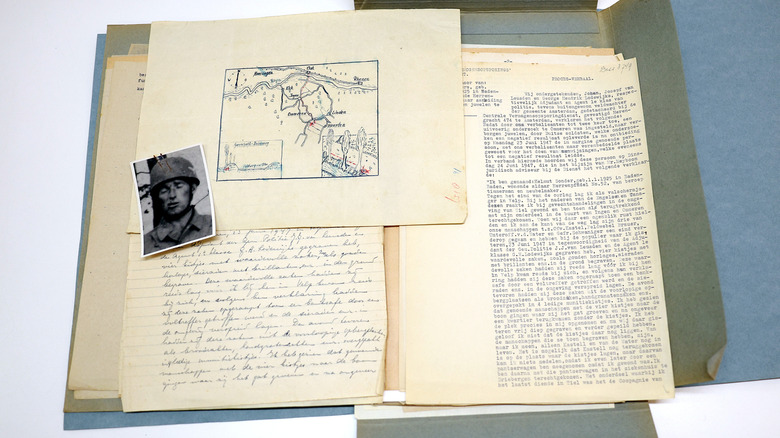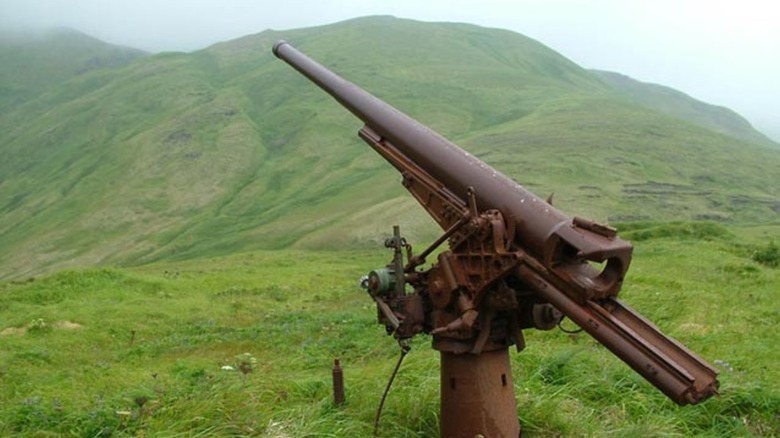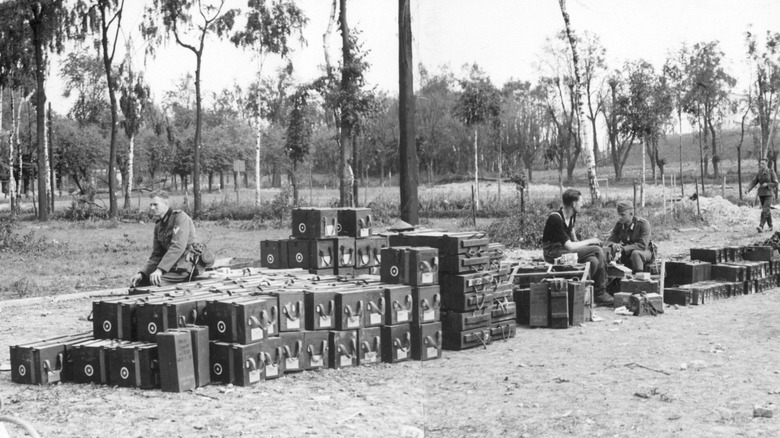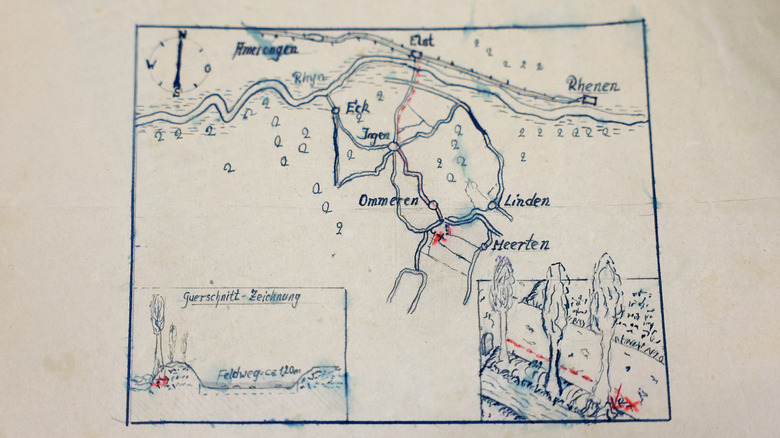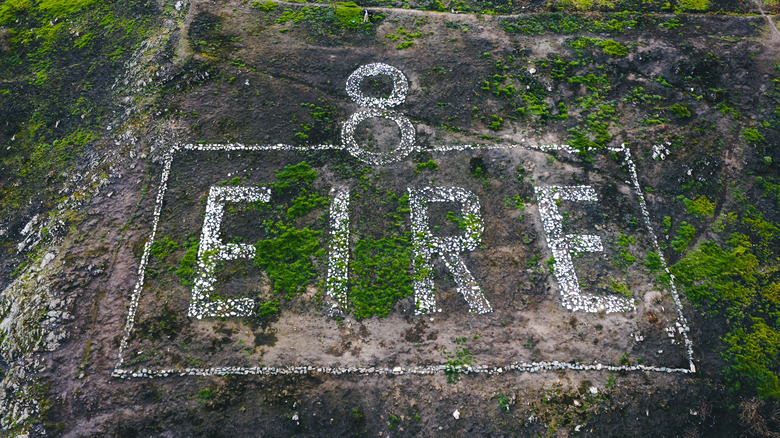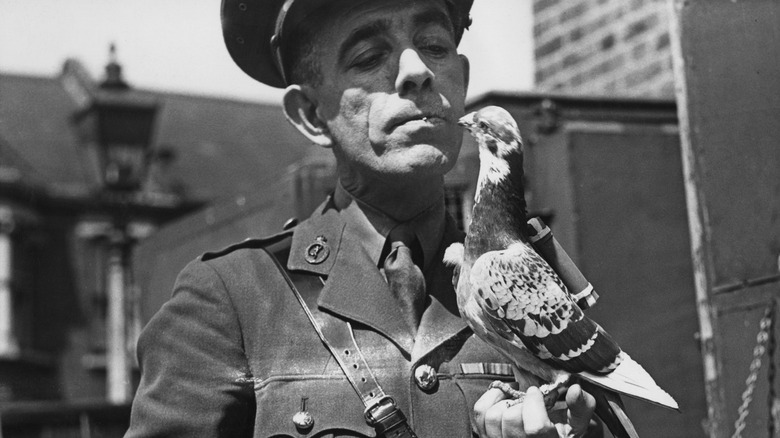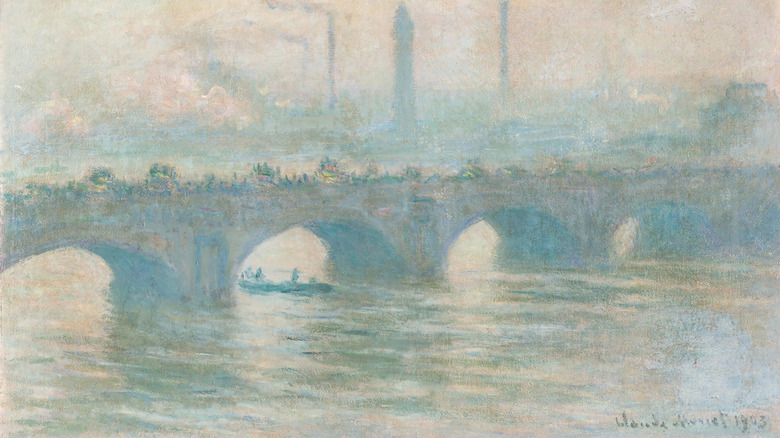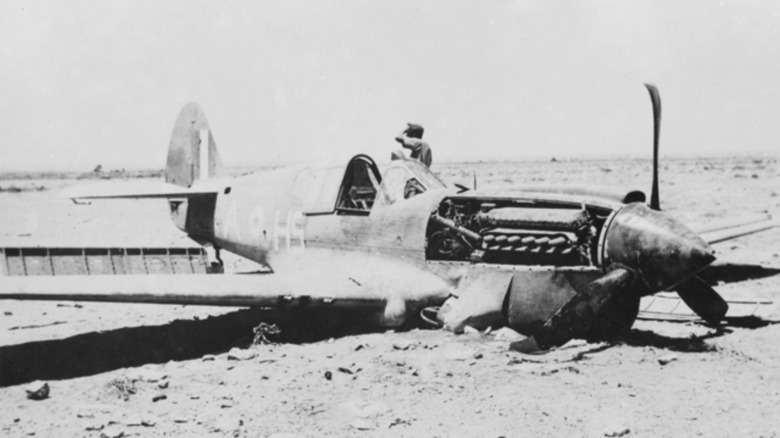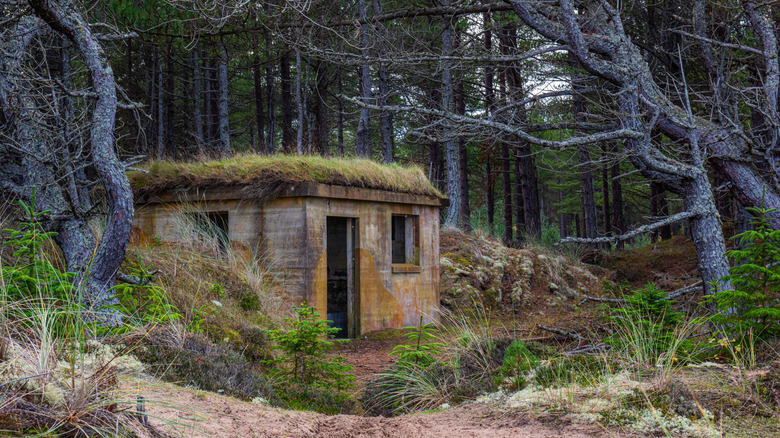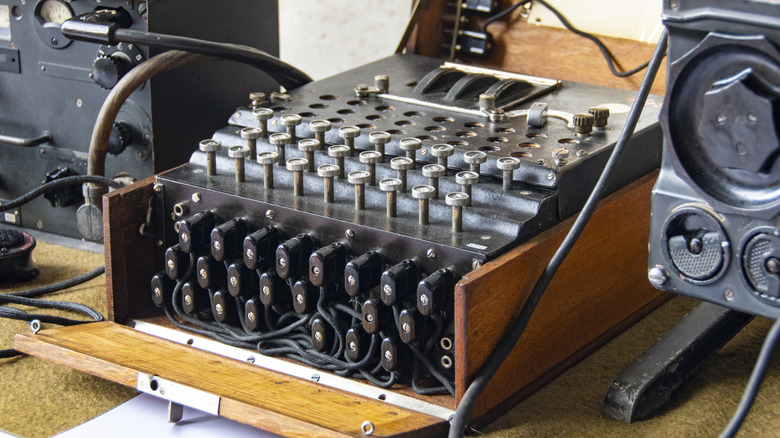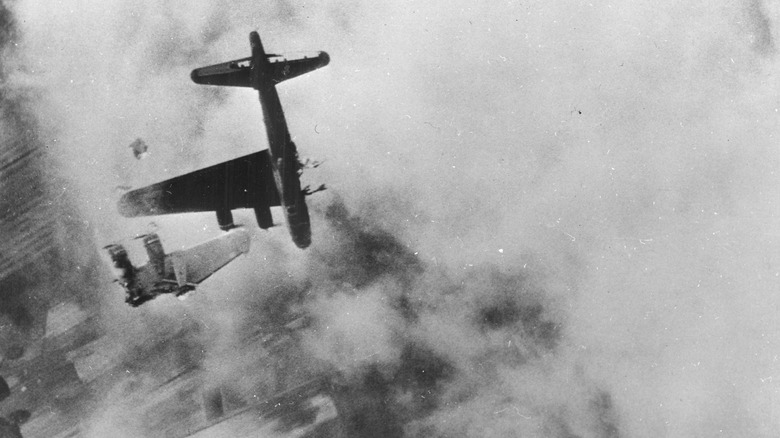Bizarre Artifacts Found From WWII
World War II was one of the most tragic losses of life in human history, both on and off the battlefield. Due to its significance and the availability of modern war photos and other media for historians, it is believed to be one of the most extensively studied topics of all time. So many books have been written on the conflict that it isn't crazy to think you could figure out what the major players were doing minute by minute over the course of those six years.
Despite its ubiquity in academia, there are still things about World War II that don't make sense, and it still has some surprises up its sleeves for researchers. War is messy, and sometimes things get lost in the chaos. Everything from treasure maps to coded messages to entire planes have been unexpectedly discovered in the decades since the war ended, all the way up to the present day. Here are some of the bizarre artifacts found from World War II.
A Japanese submarine on a desolate Alaskan island
World War II truly was a globe-spanning war, which is why an incredibly remote Aleutian island off the coast of Alaska has the rusting remains of a Japanese WWII submarine lying out in a field. Japanese forces dug in on Kiska Island in 1942, and when they fled 14 months later, they left almost everything behind, even the six Shinto shrines they had constructed. Other remnants of Japan's wartime occupation of the desolate island include the gun pictured above.
According to visitors, the combination of slowly decaying war machines, isolation, and silence is incredibly eerie. Andrew Pietruszka, an underwater archaeologist, told Archaeology Magazine, "The moment you sail in, there are partially submerged ships sticking out of the water, and you can see a Japanese midget submarine on shore. It's like the land of the lost, like you've stepped back in time to this amazing natural setting with no modern structures that is so rich in historical artifacts."
While most archaeologists and researchers visit Kiska to study the prehistoric sites on the islands, they can't escape the reminders of much more recent human activity. "Every military action which was not built over or destroyed by the American base development is still there: every single bomb crater, every single grenade crater," archaeologist Dirk H.R. Spennemann said. "The Japanese guns are still pointing skyward the same way they did when the Americans were landing. Nothing has changed."
Thousands of unexploded bombs
The Battle of Westerplatte in Poland was the first major clash of World War II. Today, this war-torn World War II spot has become a popular destination for sightseers, much like other "Dark Tourism" spots related to the war, like Auschwitz or the beaches of Normandy. However, there was one aspect of heading to the Westerplatte peninsula for your historical holiday that you wouldn't find at those other places: bombs. Just so, so many bombs.
It wasn't like there were signs warning where these still very deadly munitions were, either. Even as curious onlookers trampled over the former battlefield, archeologists were digging up thousands of all-too-real reminders of the dangers of war. Between 2016 and 2024, archaeologists found 4,700 "dangerous" objects — including three unexploded aircraft bombs, around 200 artillery shells, and hand grenades — over about 32 acres of the battlefield, which had to be sent off to be "neutralized." While many of them may have been duds or no longer worked after time underground, just one still-primed bomb would be a disaster waiting to happen.
"The Westerplatte peninsula is a historical monument visited by a great number of tourists," a spokesperson for the Museum of the Second World War in Gdańsk (MSWW) told Newsweek. "The found hazardous materials pose a direct threat to people visiting the peninsula because they still contain explosives." The group has now completed the clearing project, so you should be able to visit safely.
A map to Nazi treasure
Every year, the Dutch National Archives releases a large tranche of historical documents that it has digitized over the past 12 months. Most of these are usually only interesting to historians and genealogists, but in 2023, one of the hundreds of documents was a map with a literal red X (pictured) marking the spot in the Dutch town of Ommeren where German soldiers had allegedly buried treasure. As you can imagine, that excited a lot of people.
This was not good news for the local government, however, which worried about a disaster in the making. "Searching there is dangerous because of possible unexploded bombs, land mines, and shells," the municipality said in a statement (via the AP). "We advise against going to look for the Nazi treasure." Surprisingly, making the search for Nazi treasure sound even more badass did not put people off trying to find it.
In an attempt to deter amateur treasure hunters, an official dig was undertaken. However, neither the professionals nor the amateurs turned up any gold. "I think there's minimal chance of finding anything. We dug three holes here of places where we could find through the magnetometer. There was a signal, and none of these holes have found the treasure," archeologist Martijn Bink told the AP. "So I think this is all what we'll do. We won't go any further."
A huge lost sign letting pilots know they were over Ireland
Ireland remained neutral during WWII, and as such, it didn't want to be accidentally bombed by pilots who might think they were over the U.K. To keep any lost German pilots from getting too trigger-happy, the Irish government used rocks to build massive signs saying "EIRE" ("Ireland" in Irish) along their coasts. There were 83 of them in all.
Once the U.S. entered the war, these signs got even larger and more informative. "At the request of the United States Air Force, the number of the nearby lookout post was added, turning the signs into air navigation aids. This assisted American bomber pilots in navigating across the Atlantic," Michael Kennedy of Guarding Neutral Ireland explained to Dublin Live.
Many of the signs still dot the coast today. Despite their huge size, at least one of them managed to be lost until it was uncovered by wildfires in 2018. An Air Corps spokesperson told Ireland's The Journal, "You can make out the Eire, and just above it the number 8 – it's very faint. The number represented the Look Out Post it was designated to. When they were in proper use, the signs would have been whitewashed." (Pictured above is the rediscovered sign after it was returned to its original condition.) While the wildfires endangered houses and were devastating for the local ecosystem, finding a piece of World War II history was a small silver lining.
A code-carrying carrier pigeon
In 2012, a very dead carrier pigeon was extracted from a chimney in Bletchingley, Surrey, outside of London. Birds do sometimes get trapped in chimneys and die, but this one was special because it had a small container still attached to its skeletal leg, containing a coded message. While it was clearly from World War II, the United Kingdom's Government Communications Headquarters (GCHQ, the equivalent of the NSA in the U.S.) didn't think the code could be broken, as all the codebooks from Bletchley Park were destroyed when the war ended.
It was a surprise, then, when the code was eventually cracked by amateurs. Canadian sleuths at Lakefield Heritage Research used an artillery code book from World War I, which allowed them to decipher most of the message. Using a colloquial term for the Germans, the note said in part, "Jerry's right battery central headquarters here. Artillery observer at 'K' sector Normandy. Mortar, infantry attack panzers. Hit Jerry's Right or Reserve Battery Here. Already know electrical engineers headquarters. Troops, panzers, batteries, engineers, here" (via Business Insider).
The pigeon was sent by Sergeant William Stott, a 27-year-old paratrooper from the Lancashire Fusiliers, who had been dropped behind enemy lines in France before D-Day. Such a reconnaissance mission was incredibly dangerous, and Stott was killed a few weeks after he sent the message to his superiors in England, making him one of the many lesser-known heroes of World War II. The pigeon, as we now know, also did not survive the war, nor make it to its intended destination.
A huge cache of stolen art
On top of forcing the Jewish population into ghettos and then extermination camps, the Nazi regime also robbed Jewish families of priceless artworks. Heir to the Estée Lauder fortune, Ronald Lauder, told Vanity Fair in 2004, "The artworks stolen from the Jews are the last prisoners of World War II. You have to be aware that every work stolen from a Jew involved at least one death."
All that art eventually found its way into other collections, and over the decades, some pieces have been recovered. Then, in 2012, something astonishing happened. A search of art dealer Cornelius Gurlitt's homes revealed 1,500 looted paintings, including works by famous artists such as Henri Matisse and Claude Monet (the piece pictured above was one of them). Gurlitt had inherited the stolen art from his Nazi father and just kept it all, occasionally selling one when he needed money.
Getting the artworks back to the families who originally owned them was sadly almost impossible, however. Deidre Berger of the Ramer Institute for German-Jewish Relations told BBC News, "The reality is that it's very difficult to find the owners of most of these pieces of art. The survivors were children at the time. How should they remember precisely what a painting looked like hanging in their living room 70 years ago?" Or, as Lauder put it to Vanity Fair, "When you put them up on the Internet, everybody says, 'Hey, I remember my uncle had a picture like this.'"
A missing soldier's plane -- but not him
In 1942, RAF Flight Sergeant Dennis Copping was doing a routine flight over North Africa in a Curtiss P-40 Kittyhawk fighter, but he never reached his destination. Presumed dead, no one knew for sure what happened to Copping until this World War II mystery was finally solved 70 years later. In 2012, a worker in Egypt discovered the almost pristine plane in the Sahara desert. British military historian Andy Saunders told CNN, "The thing just landed there in the desert, and the pilot clearly got out. ... It is a complete time capsule, really, an exceptionally rare find. These things just don't happen."
Although Copping's body was not found, it's now obvious he must have walked into the desert and died. There were hopes to recover his remains, but a skeleton found nearby turned out to be unrelated to the crash site.
While plans were made to ship the plane to Britain, this turned out not to be possible, so the El-Alamein Military Museum took charge of it. They attempted to restore the plane, but some of the ahistorical choices they made sparked significant controversy. "Everyone in aircraft preservation and restoration is horrified by what they have done," Saunders told The Sunday Times. "[But] you can't expect the Egyptians to be sympathetic. It was a war fought on their territory that was nothing to do with them. And anyway, I am sure there are a few artefacts in the British Museum they would like back."
A secret German base near the North Pole
In 2016, a Russian team found the remains of a previously unknown German base on the remote Alexandra Land island in the Arctic. Named "Schatzgrabber" ("Treasure Hunter") by the Nazis, the Germans used it as a weather station to provide their military with valuable forecasts.
While it might seem like a boring job to get in the middle of a war, living on the island was just as hellish as any battlefield. Polar historian William Barr told Live Science, "It was quite disastrous — the expedition leader went crazy, and when they were flown out, he had to be strapped down to the floor of the aircraft, so he wouldn't run riot."
Even for those men who kept their sanity in the cold and isolation, plenty of disasters occurred during their time there. "Some of the supplies and equipment sank, and so the diet for the weather over the winter was rather limited. It is no surprise that they wanted some fresh meat, and so they killed polar bears, because that's all there was," Evgeny Ermolov, a senior researcher with the Russian Arctic National Park, explained. Gathering weather information would definitely not have been one of the most popular jobs during World War II.
Massive hordes of gold coins
During World War II, both soldiers and civilians hid money and other valuables in the hope that they could return for them. For those who never made it back, their caches of treasure still await discovery. In 2015, an amateur archaeologist in Germany found a stash of gold worth tens of thousands of Euros. Amazingly, a decade later, a similar horde was discovered by hikers in Czechia. Both treasures are believed to have been hidden during or right after World War II.
While the coins found in Germany were dated from 1831 to 1910, later markings indicate that they were hidden after WWII began and were likely taken as part of an inside job. "It was either someone who worked at the Reichsbank and had access, which means it could have only been someone who was there in an official role, or somebody who took advantage of the situation when the coins were being transported," Edgar Ring, an archaeologist at Museum Lueneburg, told Reuters.
The Czechia stash probably has a more tragic story behind it. "The list of potential reasons for which it was likely buried is fairly clear. It was the beginning of the war, the deportation of the Czech and Jewish populations, then the deportation of the Germans after the war, so there are several possibilities," Miroslav Novák, head of the archaeological department of the Museum of Eastern Bohemia, explained to Radio Prague International.
A secret U.K. government bunker
If the Nazis invaded, Britain was ready with a secret Auxiliary Unit and a network of hidden bunkers. After the war, these already secret bunkers were mostly forgotten, but one was rediscovered in Scotland in 2020.
Amazingly, it was the curiosity of children that ultimately led to this important discovery. Forestry and Land Scotland (FLS) survey technician Kit Rodger told BBC News, "The bunker was missing from our records, but as a child, I used to play in these woods and visit the bunker, so I knew it was there somewhere," he said. "It was 40 years ago, so I only had vague memories of the location, and the vicinity had changed a lot and was overgrown with bracken. However, I stumbled across a shallow trench, and this led to the bunker door."
Because of the rarity and historical importance of the bunker, its exact location has not been shared with the public; many would probably want to play around in it like Roodger once did. The men who used it during the war probably didn't find it particularly enjoyable, though. FLS archaeologist Matt Ritchie explained, "From records, we know that around seven men used this bunker and at the time were armed with revolvers, submachine guns, a sniper's rifle, and explosives."
An incredibly rare Enigma Machine
The Enigma machine was the Nazi's secret weapon in the beginning of the war. Arguably more important than any weapon, it allowed the German government and military to use a complex code to send encrypted messages and easily change it each day, as long as they knew the right settings and had the necessary codebook. When the Allies finally broke the Enigma code and were able to decipher up to 10% of the messages the Germans sent, it dramatically changed the tide of the war.
In 2020, a WWF team cleaning old fishing nets out of the Baltic Sea stumbled upon something odd. "A colleague swam up and said: there's a net there with an old typewriter in it," lead diver Florian Huber told the DPA news agency (via The Guardian). It turned out that "typewriter" was actually an extremely rare Enigma Machine, probably thrown overboard from a Nazi warship towards the end of the conflict to prevent it from falling into enemy hands.
"I've made many exciting and strange discoveries in the past 20 years. But I never dreamt that we would one day find one of the legendary Enigma machines," Huber told Reuters.
A mysterious plane crash remnant
In 2024, a contractor conducting peatland restoration work on Scotland's Isle of Arran discovered an old, heavy potato sack. Worried it might be filled with human remains, it was a relief when he saw it contained a World War II propeller blade. However, this was still quite a mystery, since no planes were recorded as crashing in that exact location during the war. There were two crashes nearby, but both the airplanes and the pilots' remains were carefully removed and the sites protected decades before.
"The bodies were recovered from the crash site shortly after, but the locations are still protected today under the 1986 Protection of Military Remains Act," Derek Alexander, Head of Archaeology for the National Trust for Scotland, said in a press release. "We are not permitted to remove wreckage from such sites without first obtaining permission — so the accidental discovery of a propeller blade, without the known spread of fuselage debris, that had obviously been previously moved is quite an unusual situation."
It's not clear what type of plane the propeller comes from, although it is probably part of a B-17 Flying Fortress (pictured) or a B-24 Liberator. No one knows who put it in the potato sack or why they seemingly hid it, but researchers are hoping to uncover the truth to this bizarre, unsolved mystery of World War II.
